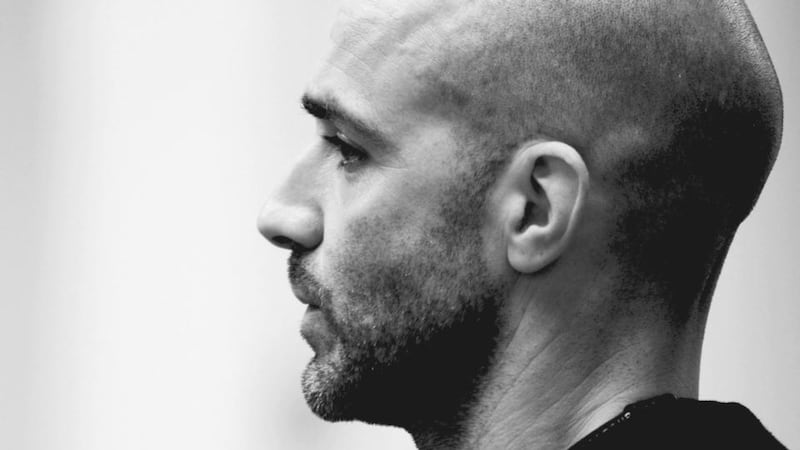Reading Russell Maliphant’s CV, nothing fits together: ballet, t’ai chi, martial arts and deep-tissue massage. Watching his choreography, it comes together perfectly. The Ottawa-born dancer and choreographer returns to Ireland this month with a collection of works that are the perfect summation of his past experience: formal, emotional, disciplined and energised, and constructed with an intimate knowledge of the body and how it moves.
"I've always been naturally curious about other movement forms, but I also want to feed that knowledge back into my choreography," he says by phone from Italy, where he is performing a duet with Sylvie Guillem. In the past year, Maliphant has created six works for companies including English National Ballet and Munich Ballet, additions to a long list that includes Robert Lepage, Balletboyz and Lyon Opera Ballet.
Catching a glimpse of Rudolf Nureyev on television dancing Le Corsaire drew the nine-year-old Maliphant to his sister's ballet class. Immediately smitten, he went on to train at the Royal Ballet School and began dancing with Sadler's Wells Royal Ballet (now Birmingham Royal Ballet).

During the company’s frequent tours, he would spurn the standard pre-performance ballet warm-up and practise t’ai chi instead. While on tour in Brazil, he discovered capoeira – a martial-arts and dance form – and sought out classes on his return to London.
These excursions into other movement forms weren’t a two-fingered protest to the ballet world, but were driven by restless curiosity for other experiences. He grew tired of Sadler’s Wells’ diet of 19th-century ballet classics, and left to channel his creativity elsewhere, initially with a small ballet company called Dance Advance. It got him noticed outside the institutionalised ballet set-up.
Serial killer choreography
DV8's Lloyd Newson is about as far away from that world as you could get: he is a brilliant and outspoken modern dance choreographer who was then focusing on all that was wrong in Thatcherite Britain.
He invited Maliphant to perform in Dead Dreams for Monochrome Men, an attack on legislation, introduced in 1988, that prevented local councils from using public money to "promote homosexuality". Dead Dreams was based on the case of serial killer Dennis Nilsen, who murdered 15 gay men at his home. Keen to further explore his interest in capoeira, Maliphant also teamed up with Laurie Booth, who combined contemporary dance, contact improvisation and the martial-art form.
To take care of his body through this busy schedule, he had some deep-tissue massage called rolfing, which was developed by Ida Rolf and involves adjusting fascia – the connective tissue around muscles – to get the skeleton aligned. “I was interested in learning more, so I did a pre-training course,” he says. This was followed by a four-year training programme to become a certified practitioner.
Rolfing gave him an insight into body movement and structure, and still influences how he works every day.
“When I’m working with my company, we start the day with movement class, which could be based on t’ai chi. Then we start a physical improvisational task, which could be about feeling the fascial sheets of the body or experiencing the hips or spine in a particular way. That then shifts to the workshop part of the day, where we try to see how that feeling can yield physical movement that we can use in whatever dance we are creating.”
That 10am to 6pm daily routine of deep exploration is a luxury not afforded by other companies. “If I’m working with a ballet company, then time is short. I might just have two or three hours a day with the dancers, so I must go in with a pretty clear idea of how to generate movement material and put that together into a structure.”
Fascinated with sculpture
Maliphant is fascinated with sculpture, an interest shared with his long-time collaborator, lighting designer Michael Hulls.
“We’re both really interested in looking at how light sculpts the body or performing space,” he says. “Recently we’ve started to explore different textures by using projections, and particularly projected animation, as a lighting source. This gives texture to the body, and the projection can be choreographed so that the stage appears to sink or grow or breathe.”
The programme touring Ireland includes Afterlight, the first piece that uses projection. It also features a solo by Dickson MBI, a body popper Maliphant spotted at Breakin' Convention 2011, and who joined him on a project about the sculptor Rodin. Hip hop and Rodin seem an incongruous mix, but his choreographic eye sees similarities in the freezing, movement waves and overall sense of gravity.
Right now, Maliphant is taking a break from choreography, as his hectic schedule of six new works in a year is completed.
“I knew it was going to be a tough year and now I’m enjoying dancing,” he says. Irish audiences will see him performing in a duet with the talented young dancer Carys Staton. But a series of commissioned solos will lure him back into the studio in the autumn. There he’ll do some research and development, drawing on his rich rattlebag of influences.
The more he learns about the body, it seems, the more inspiration it offers. “It’s an endless resource. I feel like I know a reasonable amount about the body, but it’s nothing. It’s just the tip of the iceberg.”
Still Current is at the Mac, Belfast (May 23-24), Lime Tree Theatre, Limerick (May 27), Cork Opera House (May 28) and the Abbey Theatre as part of Dublin Dance Festival (May 29-31)
DUBLIN DANCE FESTIVAL: SOMETHING FOR EVERYONE
Dance anoraks probably have their copy of Dublin Dance Festival's programme inked with circles, smiley faces and exclamation marks. For those less certain of where their tastes lie, the festival has a guide that will match a performance to your personality type.
Novices are guided by the elbow towards a recommended three-pack of Fishamble's charming dance-drama Swing, Ponydance's irreverent and riotous Ponies Don't Play Football and Gandini Juggling's Smashed. But if you're dipping your toe into the dance scene, consider Russell Maliphant's Still Current at the Abbey (see main piece). The choreographer's beguiling movement is supplemented by Michael Hull's lights and projections and great scores by Andy Cowton, Mukul and French composer Armand Amar.
The festival recommends that music lovers see choreographic collaborations with composers Nick Roth and Francesco Turrisi (Tundra) and the nature-based soundscapes of Swedish sound artist BJ Nilsen (Name of the Next Song). And musos won't be disappointed if they head to DanceHouse to witness extracts of Hear Me Sing Your Song, by Irish choreographer Liv O'Donoghue and musicians Caoimhin Ó Raghallaigh and Bryan O'Connell. The work has had a few outings as a work in progress and the musicians are integral to the action on stage, rather than just providing the beats.
There are some obvious recommendations for theatre types, with a rare performance and lecture on Beckett's Quad by Irish Modern Dance Theatre and Pan Pan Theatre Company. This has broader appeal, with mathematical neuroscientist Conor Houghton giving insight into the underlying secrets behind the movement patterns.
Arcane Collective also delve into Beckett with Return to Absence, drawing on images, emotion and humour from the writer's three novels, Molloy, Malone Dies and The Unnamable.
The festival doesn't recommend where the real raw drama might be acted out: Rain is a film about Belgian choreographer Anne Teresa de Keersmaeker mounting her contemporary classic on the dancers of the Ballet de l'Opera in Paris. It's not a bun-head-ballerina-can't- dance- modern-steps movie, but a more textured exploration of artistic discipline, uncertainty and compromise.
As with previous festivals there is a children's programme and outdoor events, including Willi Dorner's Bodies in Urban Spaces, where piles of performers in hoodies will be appearing and disappearing during an hour-long walk through the streets of Dublin. If you want to escape the city centre, Rua Red in Tallaght is hosting dance films, including Without, a seven-screen projection that Rosemary Lee created with Echo Echo Dance Theatre in Derry as part of its City of Culture celebrations.



















